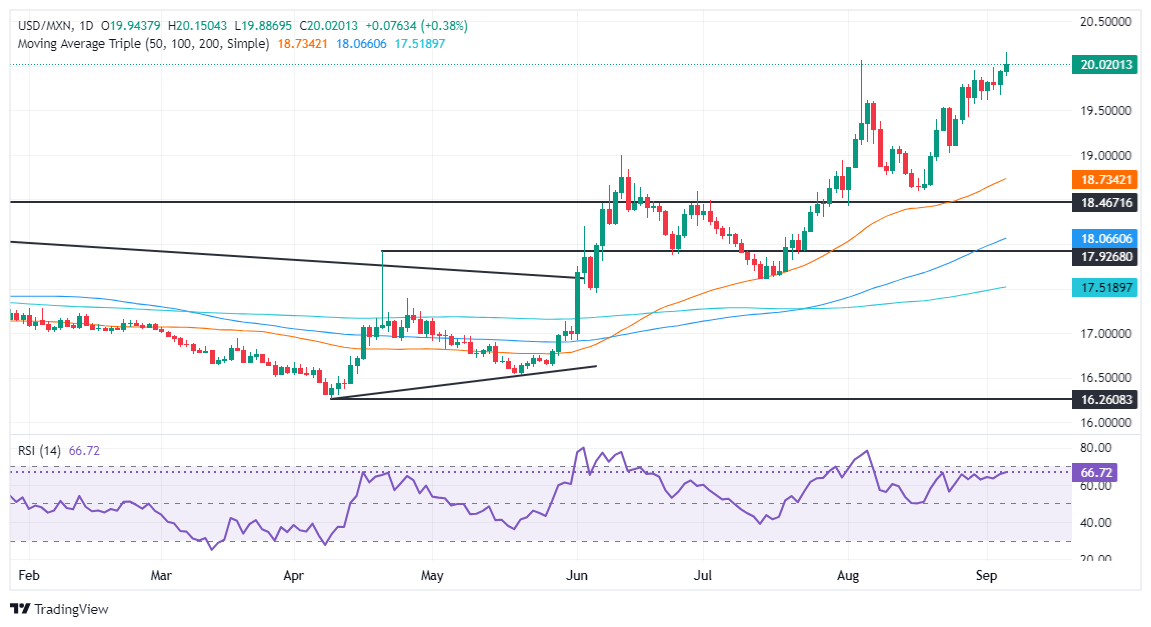- USD/MXN falls 0.20% to 19.89, after hitting a four-week high of 20.14 amid ongoing political turmoil in Mexico.
- Judicial reform bill awaits Senate approval with potential consequences for US-Mexico relations and market sentiment.
- Mexico’s upcoming inflation data and US NFP are key factors that could influence further Peso movement.
The Mexican Peso stages a late recovery against the Greenback during the New York session after hitting a four-week low of 20.14. The financial markets continued to digest the lower house decision to approve President Andres Manuel Lopez Obrador's (AMLO) bill to make changes to the judicial system. The Peso extended its losses for the third straight day and cracked the psychological barrier of 20.00 before recovering some ground, below the latter. The USD/MXN trades at 19.86, down 0.42%.
Mexico’s economic docket is scarce with investors eyeing the release of automobile industry data on Friday. Next week, inflation figures will garner attention after the Bank of Mexico (Banxico) decided to lower borrowing costs despite revising their inflation projections upward.
Back to political developments, two-thirds of the Senate must now approve the judicial reform bill. Morena’s ruling party is shy of one vote, but if the bill is cleared, it will be passed to 32 local congresses for their approval. Once the bill is approved in 17 of those states, the changes to the Mexican Constitution will be officially made.
On Tuesday, the US Ambassador in Mexico, Ken Salazar, expressed that the approval of the judiciary reform could damage relations between Mexico and the United States.
Across the border, the US docket has been busy releasing jobs and the ISM and S&P Global Services PMI data. The ADP National Employment Change for August was dismal with missed estimates and a downward revision of July’s numbers.
Even though the Greenback weakened, it was a short-lived dip. Data released by the US Department of Labor showed that the number of Americans filing for unemployment benefits was lower than expected.
According to the CME FedWatch Tool, odds for a 50 bps Fed rate cut are at 39%; while for a quarter of a percentage point, 61%.
Now that most of the data is out of the way, traders will focus on the release of the August Nonfarm Payrolls (NFP) report.
Daily digest market movers: Mexican Peso counteratacks, on mixed US data
- Mexico’s data revealed during the week show the economy is slowing due to higher interest rates set by the Bank of Mexico.
- Most banks expect the Bank of Mexico (Banxico) to reduce rates by at least 50 basis points (bps) for the remainder of 2024. This would pressure the Mexican currency, which has depreciated 17.38% year to date.
- US ADP Employment Change for August dipped from 111K to 99K, missing estimates of 145K. Contrarily, Initial Jobless Claims for the week ending August 31 slid from 232K to 227K, lower than the 230K expected.
- ISM Services PMI for August was better than projections, increasing by 51.5 from 51.4 in July, above the consensus for a 51.1 drop.
- US Nonfarm Payrolls in August are expected to grow from 114K to 163K, while the Unemployment Rate is foreseen ticking lower from 4.3% to 4.2%.
- Data from the Chicago Board of Trade (CBOT) suggests the Fed will cut at least 104 basis points this year, up from a day ago’s 103 bps, according to the fed funds rate futures contract for December 2024.
Technical outlook: Mexican Peso weakens as USD/MXN rallies above 20.00
Politics is the driver of the USD/MXN exchange rate. As traders digested the lower house approval of the bill, foreign investors had grown worried about changes to the Mexican Constitution.
Therefore, the USD/MXN cleared the 20.00 psychological barrier as buying momentum began to build as seen on the Relative Strength Index (RSI). The RSI registered a new peak, and if the uptrend gains steam, it will exert additional pressure on the Peso.
If USD/MXN clears the YTD high at 20.22, the next stop would be the September 28, 2022, daily high at 20.57. If those two levels are surrendered, the next stop would be August 2, 2022 swing high at 20.82, ahead of 21.00.
Conversely, if USD/MXN weakens further, the first support would be 19.50. A breach of the latter will expose the August 23 swing low of 19.02 before giving way for sellers eyeing a test of the 50-day Simple Moving Average (SMA) at 18.65.
Mexican Peso FAQs
The Mexican Peso (MXN) is the most traded currency among its Latin American peers. Its value is broadly determined by the performance of the Mexican economy, the country’s central bank’s policy, the amount of foreign investment in the country and even the levels of remittances sent by Mexicans who live abroad, particularly in the United States. Geopolitical trends can also move MXN: for example, the process of nearshoring – or the decision by some firms to relocate manufacturing capacity and supply chains closer to their home countries – is also seen as a catalyst for the Mexican currency as the country is considered a key manufacturing hub in the American continent. Another catalyst for MXN is Oil prices as Mexico is a key exporter of the commodity.
The main objective of Mexico’s central bank, also known as Banxico, is to maintain inflation at low and stable levels (at or close to its target of 3%, the midpoint in a tolerance band of between 2% and 4%). To this end, the bank sets an appropriate level of interest rates. When inflation is too high, Banxico will attempt to tame it by raising interest rates, making it more expensive for households and businesses to borrow money, thus cooling demand and the overall economy. Higher interest rates are generally positive for the Mexican Peso (MXN) as they lead to higher yields, making the country a more attractive place for investors. On the contrary, lower interest rates tend to weaken MXN.
Macroeconomic data releases are key to assess the state of the economy and can have an impact on the Mexican Peso (MXN) valuation. A strong Mexican economy, based on high economic growth, low unemployment and high confidence is good for MXN. Not only does it attract more foreign investment but it may encourage the Bank of Mexico (Banxico) to increase interest rates, particularly if this strength comes together with elevated inflation. However, if economic data is weak, MXN is likely to depreciate.
As an emerging-market currency, the Mexican Peso (MXN) tends to strive during risk-on periods, or when investors perceive that broader market risks are low and thus are eager to engage with investments that carry a higher risk. Conversely, MXN tends to weaken at times of market turbulence or economic uncertainty as investors tend to sell higher-risk assets and flee to the more-stable safe havens.
Information on these pages contains forward-looking statements that involve risks and uncertainties. Markets and instruments profiled on this page are for informational purposes only and should not in any way come across as a recommendation to buy or sell in these assets. You should do your own thorough research before making any investment decisions. FXStreet does not in any way guarantee that this information is free from mistakes, errors, or material misstatements. It also does not guarantee that this information is of a timely nature. Investing in Open Markets involves a great deal of risk, including the loss of all or a portion of your investment, as well as emotional distress. All risks, losses and costs associated with investing, including total loss of principal, are your responsibility. The views and opinions expressed in this article are those of the authors and do not necessarily reflect the official policy or position of FXStreet nor its advertisers. The author will not be held responsible for information that is found at the end of links posted on this page.
If not otherwise explicitly mentioned in the body of the article, at the time of writing, the author has no position in any stock mentioned in this article and no business relationship with any company mentioned. The author has not received compensation for writing this article, other than from FXStreet.
FXStreet and the author do not provide personalized recommendations. The author makes no representations as to the accuracy, completeness, or suitability of this information. FXStreet and the author will not be liable for any errors, omissions or any losses, injuries or damages arising from this information and its display or use. Errors and omissions excepted.
The author and FXStreet are not registered investment advisors and nothing in this article is intended to be investment advice.
Recommended content
Editors’ Picks

AUD/USD holds above mid-0.6300s amid mixed fundamental cues
AUD/USD consolidates near the weekly low touched on Wednesday amid fading optimism over a quick resolution to the US-China trade dispute. Moreover, easing concerns about the Fed's independence assists the USD to preserve its recovery gains registered over the past two days and acts as a headwind for the currency pair.

USD/JPY snaps a two-day winning streak to over one-week high
USD/JPY eases from over a one-week top set on Wednesday and stalls this week's recovery move from a multi-month, though it lacks follow-through selling. Concerns about the US-China trade standoff and the divergent BoJ-Fed policy expectations continue to underpin the JPY, which weighs on the currency pair.

Gold price rallies back to $3,340 area on fading US-China trade deal optimism
Gold price regains positive traction during the Asian session on Thursday and snaps a two-day losing streak to the $3,260 area, or the weekly low touched the previous day. The optimism over a possible US-China trade deal fades quickly and revives demand for the safe-haven bullion.

Russia Central Bank to launch crypto exchange for “qualified investors” - Official report
Russia is launching a government-backed crypto exchange for high-networth investors, marking a major step towards legalizing cryptocurrencies trading.

Five fundamentals for the week: Traders confront the trade war, important surveys, key Fed speech Premium
Will the US strike a trade deal with Japan? That would be positive progress. However, recent developments are not that positive, and there's only one certainty: headlines will dominate markets. Fresh US economic data is also of interest.

The Best brokers to trade EUR/USD
SPONSORED Discover the top brokers for trading EUR/USD in 2025. Our list features brokers with competitive spreads, fast execution, and powerful platforms. Whether you're a beginner or an expert, find the right partner to navigate the dynamic Forex market.




